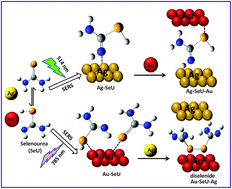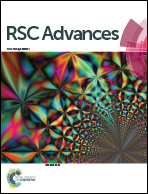Metal nanoparticle catalyzed charge rearrangement in selenourea probed by surface-enhanced Raman scattering†
Abstract
The adsorption behavior of selenourea (SeU) on noble metal silver (Ag) and gold (Au) nanoparticles (NPs) was investigated using the surface-enhanced Raman scattering (SERS) technique in combination with X-ray photoelectron spectroscopy (XPS) and density functional theoretical (DFT) calculations. SeU contains two different anchoring groups, firstly, a selenium atom and secondly, two amino groups. SERS, XPS and DFT studies provided useful insight into the metal–molecule interaction, thus, illustrating the active sites of SeU and the metal substrates being directly involved in binding. The SERS and DFT results provided further insight into the tautomerism of SeU, suggesting that as a solid, the selenone form is exclusively found. On the Ag NP surface, signatures of the selenol form were predominant which indicates charge rearrangement within the molecule while on the Au NP surface, contributions from both selenone and selenol tautomers were observed. In addition, the preferential binding affinity of the anchoring groups in SeU towards Ag and Au was exploited for the synthesis of metal–molecule–metal sandwiched nanoassemblies that further suggested possible charge rearrangement within the molecule.


 Please wait while we load your content...
Please wait while we load your content...